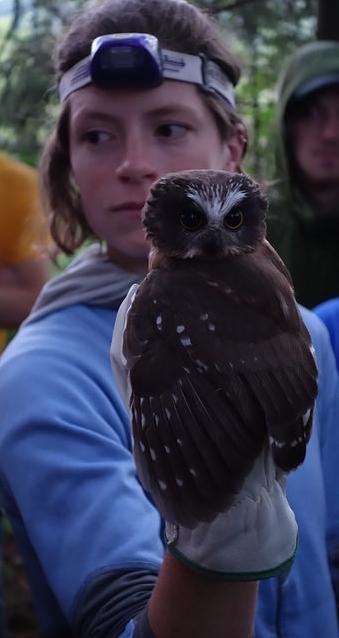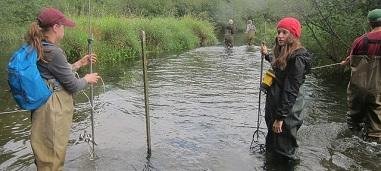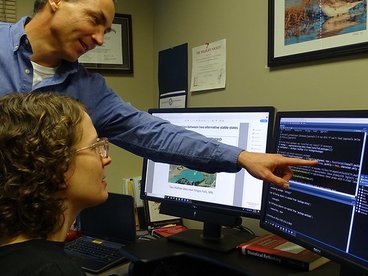Our researchers seek ways to advance informed natural resource decision-making about wild animal populations and the habitats and landscapes they depend on. We are active throughout Minnesota, the Upper Midwest, the US, and the world. Recent research activities of individual faculty are described in the “Faculty” section of the department website.
FWCB has research facilities in 5 buildings on the Saint Paul campus, which includes computer laboratories, analytical facilities, wet-labs with dedicated wells and water conditioning equipment, and fish growth facilities. Field facilities across Minnesota are available to FWCB researchers and include the Cloquet Forestry Center, Cedar Creek Natural History Area, the Minnesota Landscape Arboretum, the Itasca Biological Station, and the network of Research and Outreach Centers.
Several FWCB faculty are affiliated with the Bell Museum of Natural History. The scientific collections of the Bell Museum of Natural History consist of nearly 4 million specimens of mammals, birds, fish, plants, mollusks, and insects provide research and learning opportunities.
Avian Conservation & Management
FWCB faculty and their students conduct research on the ecology of a wide array of birds, including songbirds, game birds, raptors, shorebirds, owls, and waterbirds. Of particular interest is understanding how birds use habitats and how human-caused changes to these habitats affect their populations.
David Andersen (Professor) studies the ecology of raptors, woodcock, and forest songbirds to understand how they use managed habitats and landscapes. He also studies the ecology of geese and other breeding birds in arctic landscapes. David is Leader of the Minnesota Cooperative Wildlife Research Unit.
Todd Arnold (Professor) develops methods to estimate population size and vital rates (e.g., nest success, brood survival) of wetland and grassland birds. He uses this information to model how management actions might change populations of birds, such as waterfowl.
Rob Blair (Professor) examines how changes in land use, especially urbanization, affects birds that reside in human-dominated landscapes, such as cities.
Francesca Cuthbert (Professor): studies (1) Great Lakes Piping Plovers to inform endangered species recovery, (2) biology and management of Double-crested Cormorants in North America especially in relation to the cormorant-fishery conflict; and (3) colonial waterbird population dynamics and conservation in the Great Lakes and Asia.
Sushma Reddy (Breckenridge Chair of Ornithology and Assistant Professor) works on a broad range of topics related to the evolution and genetics of birds. She is curator of birds at the Bell Museum of Natural History.
Fisheries Conservation & Management
FWCB faculty and their students use cutting-edge methods, such as those from chemical ecology and ecological modeling, as well as field studies, to understand the biology and evolution of fishes as well as solve practical ecological problems such as best approaches for responding to climate change, harvest, and invasive species control.
Przemek Bajer (Research Assistant Professor) studies movement, reproductive strategies, seasonal aggregations, and cognitive abilities of invasive fish to develop integrated and targeted management strategies.
Solomon David (Assistant Professor) studies the conservation and ecology of migratory and "Ancient Sport Fish", e.g. gars and bowfins and peripheral populations. Dr. David also uses science communication to increase awareness of the value of aquatic ecosystems.
Kassandra Ford (Assistant Professor) studies the evolution of similar adaptations or traits in distantly related taxa on multiple levels of organization: genetics, development, morphology, function, and ecology.
Gretchen Hansen (Assistant Professor) researches the effects of multiple stressors, e.g, climate change, invasive species, eutrophication on fish populations and food web dynamics.
Loren Miller (Adjunct Associate Professor) applies genetic principles and techniques to questions of fisheries management and ecology. Dr. Miller, a DNR researcher, supervises the Aquatic Genetics laboratory.
Raymond Newman (Professor) focuses on how the biology of aquatic species and their interactions in lakes can be used to develop methods to control aquatic invasive plants and restore lake fisheries.
Nick Phelps (Assistant Professor) studies fish diseases and fish health, more generally. Dr. Phelps is Director of the Minnesota Aquatic Invasive Species Research Center.
Andrew Simons (Professor) uses molecular techniques to understand the evolutionary history of fishes, such as minnows and carp. More recently, he has been studying trophic shifts in fish over evolutionary time scales.
Peter Sorensen (Professor) studies fish pheromones and uses this information to develop control methods for aquatic invasive species, such as carp and sea lamprey.
Mark Hove (Research Fellow) studies the life cycles of the freshwater mussels and develops reintroduction strategies. He leads the Minnesota Native Mussel Project.
Habitat and Ecosystem Conservation & Management
Understanding how wild animals use habitats and landscapes is a topic of research interest to many FWCB faculty and their students working on fish, mammals and birds. Several FWCB faculty work primarily on habitats and ecosystems, understanding mechanisms fundamental to ecosystem conservation, and developing strategies for ecosystem restoration or management.
Joseph Bump (Associate Professor and Gullion Chair) studies how wildlife interactions affect ecosystem processes and biodiversity, especially in forested systems.
Susan Galatowitsch (Professor and Head) studies the restoration ecology of wetlands, rivers, and prairies. Her team focuses on developing revegetation practices, restoration assessment tools, and invasive species control methods.
Daniel Larkin (Associate Professor/Extension Specialist) focuses on the ecology, restoration and management of aquatic and wetland invasive plants, as well as grasslands.
Raymond Newman (Professor) studies tropic relations of streams and littoral zones of lakes to answer both basic and applied questions related to fisheries management.
Jim Perry's (Professor) current research focuses on understanding the risks climate change poses to heritage sites and developing climate change adaptation strategies to guide protected area management.
Mammal Conservation & Management
Quantitative Methods for Natural Resource Decision-Making
Development, application, and evaluation of quantitative methods that can be applied across systems is critical to informing conservation and natural resource decision-making. FWCB research in quantitative methods spans population biology and modeling, movement and spatial modeling, ecosystem services and decision science, sampling methods to improve detection and reduce bias, causality, and inference in ecological data, and statistics applied to ecological and environmental problems.
Todd Arnold (Professor) develops methods to estimate population size and vital rates (e.g., nest success, brood survival) of wetland and grassland birds. He uses this information to model how management actions might change populations of birds, such as waterfowl.
John Fieberg (Associate Professor) develops statistical and mathematical models that are used to analyze population trends and habitat use in a variety of ecosystems and species.
James Forester (Associate Professor) studies how animals alter their habitat selection and movement paths in response to variability in resources and risk.
Conservation & Management through Community Engagement
FWCB faculty and their students are engaged in several different aspects of the connections between people and natural resources. Our social scientists study how and why individuals and communities make choices about natural resource issues. Our extension specialists are developing ways for citizen scientists to contribute to conservation research and service.
Rob Blair (Professor/Extension Specialist) founded the Minnesota Master Naturalist program, which is a volunteer program that promotes awareness, understanding, and stewardship of Minnesota's natural environment by developing a corps of well-informed citizens dedicated to conservation education and service within their communities.
David Fulton (Professor, Assistant Coop Leader) focuses on understanding and improving decision processes in the conservation and management of fish and wildlife, using methods from sociology and psychology.
Daniel Larkin (Assistant Professor/Extension Specialist) develops programs for citizens and professionals working to manage aquatic invasive species.
Kristen Nelson (Professor) studies how social institutions and organizations support resource conservation and development, including community-level carbon mitigation projects and community-led biodiversity efforts.
Reptile & Amphibian Conservation Biology
FWCB faculty and their students conduct research on the ecology and evolution of a wide array of animals, in order to inform the conservation of biodiversity. Amphibians and reptiles are among these groups.
Ken Kozak (Associate Professor) reconstructs the evolutionary history of populations and species using molecular techniques. Many of his recent projects have focused on salamanders.
The Bell Museum of Natural History maintains an amphibian and reptile collection, containing approximately 15,000 specimens. For more information, go to: Amphibian and Reptile Collection
Invasive Species Biology
FWCB faculty and their students are at the forefront of invasive species biology - most notably problematic aquatic species such as carp, zebra mussels, and Eurasian water milfoil. We also work on invasive species in other habitats including forests and wetlands. Many of our faculty are part of the Minnesota Aquatic Invasive Species Research Center.
Przemek Bajer (Research Assistant Professor) studies movement, reproductive strategies, seasonal aggregations and cognitive abilities of invasive fish to develop integrated and targeted management strategies.
Robert Blair (Professor) studies urban land use effects on bird communities, which includes responses to invasive species, such as earthworms.
Susan Galatowitsch (Professor) develops strategies to restore wetlands and riparian systems infested with invasive plant species such as reed canary grass and common reed.
Gretchen Hansen (Assistant Professor) researches the effects of multiple stressors, e.g, climate change, invasive species, eutrophication on fish populations and food web dynamics.
Daniel Larkin (Associate Professor) focuses on the ecology, restoration and management of aquatic and wetland invasive plants.
Raymond Newman (Professor) focuses on how the biology of aquatic species and their interactions in lakes can be used to develop methods to control aquatic invasive plants and restore lake fisheries.
Nicholas Phelps (Assistant Professor) studies fish diseases and fish health, more generally. Dr. Phelps is Director of the Minnesota Aquatic Invasive Species Research Center.



